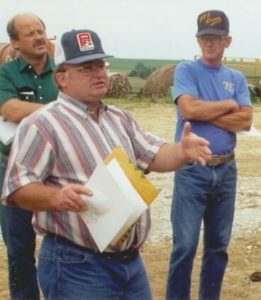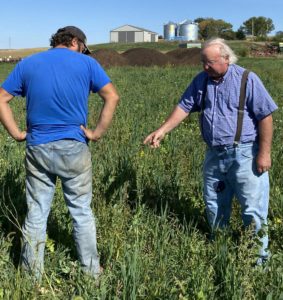Expanding Our Work to Create Viable Farms
PFI was founded, in part, to help farmers reduce reliance on external inputs. Key in this journey has been the quest to reduce dependence on synthetic nitrogen. Nitrogen reduction trials were some of the first trials PFI organized, following in the footsteps of PFI co-founders Dick and Sharon Thompson.
In “Thompson Agriculture Alternatives” – a document that expresses their philosophies about farming and shares summaries of their years of on-farm research results – Dick and Sharon say, “Less nitrogen applied to the land will result in less nitrogen in the water table. Less money spent by the farmer to purchase nitrogen will mean more money in the farmer’s pocket.”
Nitrogen Trials Then and Now

Continuing Curiosity: Vic Madsen, of Audubon, Iowa, has been working to reduce nitrogen use on his farm for decades through diverse crop rotations and data gathered from on-farm research. Vic presents on-farm research during a PFI field day in the early 1990s.
From 1988-1993, the first generation of PFI farmers explored the Thompsons’ premise in on-farm research trials comparing how low and high nitrogen rates affected yield. Over the course of the trial, cooperators saw mostly statistically equivalent corn yields between the different rates. Vic Madsen, who was part of those early trials, says, “The confidence factor was the biggest thing. This project gave us confidence to not put on 150-200 pounds of nitrogen per acre like the neighbors and most everyone else was doing. When other cooperators have similar results as you, you realize you’re not alone. We all learned we could get by with less than was popular at the time.”
Today, a new generation of PFI farmers are revisiting this question. Spurred in part by a surge in nitrogen costs, along with a scarcity of commercial nitrogen and increased cover crop use, they are motivated by the same reasons as earlier members: keeping their farms going, and stewarding the land. Read more about this new PFI fertilizer reduction trial on pages 18-23 and meet some of the farmers participating.
Scaling Farm Viability Efforts
We’re also helping farmers reduce inputs by devoting more staff and funds to our field crops cost-share programs, which offer technical assistance and financial incentives to plant cover crops and small grains. Thanks to substantial funding we secured, our farm viability department will offer personalized support to help even more farmers achieve their goals and long-term viability. These efforts are part of our strategic plan goal to create healthy environments stemming from responsible land stewardship.
We’re also excited to add new cost-share programs for regenerative grazing, habitat and food safety for fruit and vegetable growers. Supporting diverse farm practices will help us achieve another strategic plan goal: thriving rural communities filled with resilient and profitable farms.
New Faces
To successfully provide this new programming, we are investing in people and processes to get more work done and create more reasonable workloads for staff. Fortunately, funders have stepped up to help us invest in our operations department, helping us reach our strategic goal: PFI well-positioned for success, impact and growth. With this growth, you’ll notice a lot of new faces among PFI staff!
Simultaneously, PFI has not been immune to the “great resignation,” during which record numbers of people have quit their jobs; we have experienced significant turnover this past year. The good news is that people are moving on to advance career goals. The bad news is we greatly miss the talent and personalities these people brought to PFI. Fortunately, we see many of them regularly as they continue to be partners and PFI members. We are working to get the word out about whom to contact as our programs and staff grow. When in doubt, simply contact me and I’ll route you to the person best suited to help you engage with PFI.
We also have many new faces among PFI’s membership. We have hit another high: 6,000 members. More PFI members means more curious farmers and a bigger community to learn from. As we grow, we are continuing to figure out how to retain the close-knit feel so important to PFI’s community. If you want to host a social or join our welcoming committee, please let me know.
These are exciting, busy times at PFI. Please continue to read our weekly e-newsletter, Practical News, to make the most out of your PFI membership. As we continue to expand, please reach out and let me know what you want to learn more about—programs, people, strategic plan, I’d love to talk with you more!

